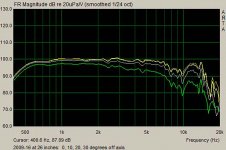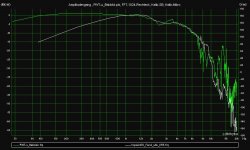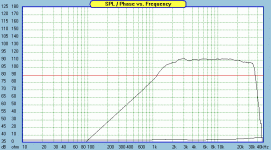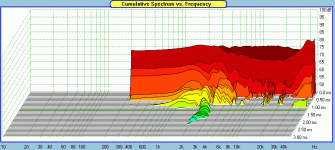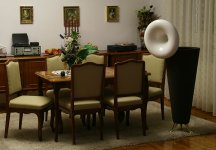Here's one of Gary's measurements of the GPA 288 at 0, 10, 20, and 30 degrees off-axis. Since I've been planning on using a supertweeter coming in around 7~8 kHz anyway, the lack of extended HF is not of much concern.
In addition, large-format drivers with 2.88" to 4" diaphragms are well known for breaking up above 7 kHz. The behavior of a phase plug is kind of moot when the driver is breaking up, since this is a chaotic region of operation, and the diaphragm's motion is nonlinear by definition. Once this starts happening, I want to roll the driver off, not boost it further - unfortunately, boost EQ in the breakup region is standard practice in the movie theater and SR world.
True, small-format drivers break up one-half to a full octave above large-format drivers, but they give up an equal amount on the LF end. You get a decade of (good) response no matter what format you choose. True, beryllium diaphragms extend another half-octave or so, but even they are not a thing of beauty above 15 kHz.
In addition, large-format drivers with 2.88" to 4" diaphragms are well known for breaking up above 7 kHz. The behavior of a phase plug is kind of moot when the driver is breaking up, since this is a chaotic region of operation, and the diaphragm's motion is nonlinear by definition. Once this starts happening, I want to roll the driver off, not boost it further - unfortunately, boost EQ in the breakup region is standard practice in the movie theater and SR world.
True, small-format drivers break up one-half to a full octave above large-format drivers, but they give up an equal amount on the LF end. You get a decade of (good) response no matter what format you choose. True, beryllium diaphragms extend another half-octave or so, but even they are not a thing of beauty above 15 kHz.
Attachments
Last edited:
By way of comparison, here's a set of measurements Bjorn Kolbrek made a few years ago on his plane-wave tube. A vintage Altec 288B is shown in green, and a JBL 2470 is shown in white. The AH-425 isn't quite as smooth as the PWT, but it's getting there. It's certainly a different world than the Altec 511 and 811 sectoral horns.
Attachments
Last edited:
To add to Gary Dahl's comments, in my own system, I'll audition the GPA 288 vs the Radian 745P, and decide from there. Same thing for the bass driver: the GPA 416 vs the AESpeakers TD15M, in a 4.5 to 5.5 cubic-foot resistive-vent box. Planet10 has been very helpful in suggesting starting-point alignments for the resistive-vent box.
I fully respect the more mainstream choice of a small-format compression driver combined with a 15" high-efficiency woofer; that format goes all the way back to the fabled Lansing Iconic of 1936. It keeps things simple with a 2-way design, and retains high efficiency and low distortion. My choice is a little different: I'm willing to use a supertweeter above 7 kHz, and prefer to cross the 15" woofer a bit lower than the usual 950 Hz to 1.2 kHz crossover for an Iconic-type 2-way speaker.
I fully respect the more mainstream choice of a small-format compression driver combined with a 15" high-efficiency woofer; that format goes all the way back to the fabled Lansing Iconic of 1936. It keeps things simple with a 2-way design, and retains high efficiency and low distortion. My choice is a little different: I'm willing to use a supertweeter above 7 kHz, and prefer to cross the 15" woofer a bit lower than the usual 950 Hz to 1.2 kHz crossover for an Iconic-type 2-way speaker.
Last edited:
A couple of us got together a couple weeks ago and compared the JBL E145, TAD 1601, and Lambda TM15M. Although all three drivers were outstanding, the TD15M was the hands down winner for me and most of us.
If you are using a 2" CD, you also might want to look at the TrueXtent berrilium diaphragm in the JBL 244X body. No need for a tweet with that.
If you are using a 2" CD, you also might want to look at the TrueXtent berrilium diaphragm in the JBL 244X body. No need for a tweet with that.
I have found most harshness in this type of breakup mode shown in the data is audible when listening to tenors sing. Lynn's decision to use a super tweeter is a good one. With a breakup mode at around 20KHz, I've tried using a super tweeter staring from 10KHz with very good results.No, never. I mostly listen to all kinds of jazz and instrumental classical.
...
Last edited:
Super tweeter CTC
Don't you run into problems with super tweeters when the center to center spacing between the super tweeter and the tweeter/ horn are several to tens of wavelengths apart at the crossover frequency in all three planes?I have found most harshness in this type of breakup mode shown in the data is audible when listening to tenors sing. Lynn's decision to use a super tweeter is a good one. With a breakup mode at around 20KHz, I've tried using a super tweeter staring from 10KHz with very good results.
This is one of the few areas in audio where you can "cheat" and get away with it.
Normally, it's a big no-no to have drivers several wavelengths apart at the crossover frequency. The resulting lobes (in the vertical plane) are so close together you can go from flat response to deep nulls by only moving a few inches. In addition to making measurements rather critical (where is the listening axis intended to be?), in the real world, the nulls are usually audible as a swishing sensation as you move up and down.
But ... I've designed systems with supertweeters before. What is a big deal at 1.8 or 3.5 kHz is almost completely inaudible from 7 kHz and above. The most sensitive subjective program material is pink-noise, and moving around to listen for swishing, shortwave-radio noise. Above a certain critical frequency, it is very hard to hear - maybe because there is very little sensation of pitch above 7 kHz.
The net result is that what normally would be bad practice - drivers separated by several wavelengths at the crossover frequency - is something you can get away with. I've tried it: to even tell if the supertweeter is on or not, it takes close listening; you flip the switch at the listening position, and all you hear is a little more air and spaciousness at the top. The effect on timbre is fairly minor, while toggling a tweeter on and off with crossover set to 3.5 kHz is much more obvious.
The subjective effects of a narrow notch in the 7~10 kHz range are even more subtle, and primarily affect apparent sensations of image height (this falls in the region of comb filtering by the outer ear, or pinna). Try it for yourself; you can hear it, if you try and listen for it, but it's difficult to pin down exactly what you're hearing if you didn't already know in advance.
By contrast, 1/2 dB changes in level in the 1~3 kHz region are gross and obvious, and have a immediate effect on voice tonality, midrange "presence", and front-to-back spatial perception. This region is extremely critical and demands careful work with the crossover and the right balance of direct vs room energy. To sum up, the location in the spectrum makes all the difference - different regions sound very different from each other, and much of the work of designing and balancing a speaker is knowing where you can conceal things and where you can't. The visual spectrum is similar; most people can easily detect a 1-degree change in color phase at colors near to fleshtone (thus, the notorious NTSC "tint" control on American color TVs), while 20-degree shifts in the blue-green (cyan) range are quite hard to see, unless you are a color-matching expert.
Another benefit of a supertweeter (with a crossover at 7 kHz or above) is the ability to control direct vs room energy in a region where most drivers are becoming pretty directive. To my ears, a speaker system that leaves the listening room "dark" sounds dry on most classical and live-recorded music. I like more air and "space" around the instruments. This is where one or more supertweeters - some aimed at the ceiling or back wall - can come in handy. Sit in the listening position and turn the knobs on the supertweeter(s) until the HF perspective sounds about right - that is, like a real acoustic space. This is a pretty easy subjective adjustment: too much is splashy and edgy-sounding, while too little is closed-in, flat and dull.
If the supertweeters are too rough, you'll never find the right balance - it'll sound wrong no matter what the level is. That's a sign to try a better (flatter) tweeter. Don't be sucked in by optimistic manufacturer's curves; measure for yourself.
Normally, it's a big no-no to have drivers several wavelengths apart at the crossover frequency. The resulting lobes (in the vertical plane) are so close together you can go from flat response to deep nulls by only moving a few inches. In addition to making measurements rather critical (where is the listening axis intended to be?), in the real world, the nulls are usually audible as a swishing sensation as you move up and down.
But ... I've designed systems with supertweeters before. What is a big deal at 1.8 or 3.5 kHz is almost completely inaudible from 7 kHz and above. The most sensitive subjective program material is pink-noise, and moving around to listen for swishing, shortwave-radio noise. Above a certain critical frequency, it is very hard to hear - maybe because there is very little sensation of pitch above 7 kHz.
The net result is that what normally would be bad practice - drivers separated by several wavelengths at the crossover frequency - is something you can get away with. I've tried it: to even tell if the supertweeter is on or not, it takes close listening; you flip the switch at the listening position, and all you hear is a little more air and spaciousness at the top. The effect on timbre is fairly minor, while toggling a tweeter on and off with crossover set to 3.5 kHz is much more obvious.
The subjective effects of a narrow notch in the 7~10 kHz range are even more subtle, and primarily affect apparent sensations of image height (this falls in the region of comb filtering by the outer ear, or pinna). Try it for yourself; you can hear it, if you try and listen for it, but it's difficult to pin down exactly what you're hearing if you didn't already know in advance.
By contrast, 1/2 dB changes in level in the 1~3 kHz region are gross and obvious, and have a immediate effect on voice tonality, midrange "presence", and front-to-back spatial perception. This region is extremely critical and demands careful work with the crossover and the right balance of direct vs room energy. To sum up, the location in the spectrum makes all the difference - different regions sound very different from each other, and much of the work of designing and balancing a speaker is knowing where you can conceal things and where you can't. The visual spectrum is similar; most people can easily detect a 1-degree change in color phase at colors near to fleshtone (thus, the notorious NTSC "tint" control on American color TVs), while 20-degree shifts in the blue-green (cyan) range are quite hard to see, unless you are a color-matching expert.
Another benefit of a supertweeter (with a crossover at 7 kHz or above) is the ability to control direct vs room energy in a region where most drivers are becoming pretty directive. To my ears, a speaker system that leaves the listening room "dark" sounds dry on most classical and live-recorded music. I like more air and "space" around the instruments. This is where one or more supertweeters - some aimed at the ceiling or back wall - can come in handy. Sit in the listening position and turn the knobs on the supertweeter(s) until the HF perspective sounds about right - that is, like a real acoustic space. This is a pretty easy subjective adjustment: too much is splashy and edgy-sounding, while too little is closed-in, flat and dull.
If the supertweeters are too rough, you'll never find the right balance - it'll sound wrong no matter what the level is. That's a sign to try a better (flatter) tweeter. Don't be sucked in by optimistic manufacturer's curves; measure for yourself.
Last edited:
Coaxial
A small 3/4" neo tweeter like the excellent Dayton ND20 could be fun to play with for very little cash. It is possible that with the flange trimmed down and a model rocketry nose cone attached to the back, it might be miniscule and aero-dynamic enough to hang inside the horn mouth without creating many reflections, to form a coaxial.
.
Parts-Express.com ayton ND20FB-4 Rear-Mount 3/4" Neodymium Dome Tweeter | tweeter nd20fb-4 soft dome tweeter dome tweeter neodynium dayton audio dayton loudspeaker dayton zdt35-60608 POTT-080108 DayAudiTweetWoofMid050109
ayton ND20FB-4 Rear-Mount 3/4" Neodymium Dome Tweeter | tweeter nd20fb-4 soft dome tweeter dome tweeter neodynium dayton audio dayton loudspeaker dayton zdt35-60608 POTT-080108 DayAudiTweetWoofMid050109
.
I guess it does make sense if you think about how small the wavelengths are at 7kHz. less than 2 inches. The comb lobes will be so small as to blend together.This is one of the few areas in audio where you can "cheat" and get away with it.
Normally, it's a big no-no to have drivers several wavelengths apart at the crossover frequency. The resulting lobes (in the vertical plane) are so close together you can go from flat response to deep nulls by only moving a few inches. In addition to making measurements rather critical (where is the listening axis intended to be?), in the real world, the nulls are usually audible as a swishing sensation as you move up and down.
But ... I've designed systems with supertweeters before. What is a big deal at 1.8 or 3.5 kHz is almost completely inaudible from 7 kHz and above.
A small 3/4" neo tweeter like the excellent Dayton ND20 could be fun to play with for very little cash. It is possible that with the flange trimmed down and a model rocketry nose cone attached to the back, it might be miniscule and aero-dynamic enough to hang inside the horn mouth without creating many reflections, to form a coaxial.
.
Parts-Express.com
.
Attachments
...
It is possible that with the flange trimmed down and a model rocketry nose cone attached to the back, it might be miniscule and aero-dynamic enough to hang inside the horn mouth without creating many reflections, to form a coaxial.
I'm thinking the opposite.
Small tweeter hung in a big horn and the tweeter in a coaxial driver with front horn loading are facing the same problem -- the wide dispersions of the tweeters would inevitably hit the horn wall (probably in the midway) and cause reflections.
Unless the "horn" flare is very very very wide and shallow.
If the small tweeter hang in a big horn is placed upfront near the mouth, then the benefit of physical alignment is gone.
X, Y alignment
A super tweeter hanging up near the mouth has perfect X, Y alignment. The Z axis time alignment will be off by 12 inches but can be compensated for in the digital delay of a pc cross. To physically time align the Z axis, and the X axis with the tweeter above the horn, the Y axis will have to go up to 2 feet or more to clear the obstruction. Take your pick. That's the problem with super tweeters in any speaker configuration. They really don't fit any where near a wavelength of the next driver. Especially not with these gigantic horns. Personally, I'm leaning towards a 1 inch Radian driver that can play well up to 16kHz and is still reported to to extend to 585Hz with an FS of 525 on a 400Hz horn for a 700Hz crossover.If the small tweeter hang in a big horn is placed upfront near the mouth, then the benefit of physical alignment is gone.
That Radian sounds like it might be doing too much to be good at any one thing. I run Radian diaphragms in my JBL 2441 and love them so nothing against Radian.
My big *** Heils run on the ESS from 1200hz to 20khz and sound very thin in the midrange. I run them from 5khz on up as tweeters and they work great. I know I MUST have a time Alignment issue but as they are di-pol or bi-pol (I can never figure out which one) the issue is not bothersome.
My big *** Heils run on the ESS from 1200hz to 20khz and sound very thin in the midrange. I run them from 5khz on up as tweeters and they work great. I know I MUST have a time Alignment issue but as they are di-pol or bi-pol (I can never figure out which one) the issue is not bothersome.
Hello,
May be I yet gave the link but it seemed to me that it is interestin to give it in this moment of the discussion.
You'll find on that page :
Electroacoustique Comparaison de pavillons 2''
very interesting measurements (on and off axis response, impulse response, distortion, CSD...) performed by Cyrille Pinton on a JBL2445 compression driver mounted on various horns one of those is a Le CLéac'h horn having and Fc of 320Hz which was commercialized few times ago by my friend Marco Henry (Musique Concrète) under the reference Jerzual 322:
(take care the graphs are animated gifs with a few second time lapse between diplaying a different horn)
Apart the Jerzual / Le Cléac'h horn you can see the JBL 2380A and the Beyma TD-400, see picture at:
http://cyrille.pinton.free.fr/electroac/experiences/pavillons-2445j/pavillons.jpg
Best regards from Paris, France
Jean-Michel Le Cléac'h
May be I yet gave the link but it seemed to me that it is interestin to give it in this moment of the discussion.
You'll find on that page :
Electroacoustique Comparaison de pavillons 2''
very interesting measurements (on and off axis response, impulse response, distortion, CSD...) performed by Cyrille Pinton on a JBL2445 compression driver mounted on various horns one of those is a Le CLéac'h horn having and Fc of 320Hz which was commercialized few times ago by my friend Marco Henry (Musique Concrète) under the reference Jerzual 322:
(take care the graphs are animated gifs with a few second time lapse between diplaying a different horn)
Apart the Jerzual / Le Cléac'h horn you can see the JBL 2380A and the Beyma TD-400, see picture at:
http://cyrille.pinton.free.fr/electroac/experiences/pavillons-2445j/pavillons.jpg
Best regards from Paris, France
Jean-Michel Le Cléac'h
Last edited:
so, I need a Jerzual !!! ;-)
that why I got every one Lecleac'h horn in my systeme;
Also I made one for the ET703 (+ TD4001 on J322) ...
Now, I need to experience a 180Hz Iwata-JMLC to use 2" JBL 2482 down to 300Hz + TD2001 on J501...
Any one interested in a "big" 2" horn really capable to go 300Hz without distorsion?
Jzagaja needs 10 guys for that project to bigin a mold without cuting a leg for each other.
FRED
that why I got every one Lecleac'h horn in my systeme;
Also I made one for the ET703 (+ TD4001 on J322) ...
Now, I need to experience a 180Hz Iwata-JMLC to use 2" JBL 2482 down to 300Hz + TD2001 on J501...
Any one interested in a "big" 2" horn really capable to go 300Hz without distorsion?
Jzagaja needs 10 guys for that project to bigin a mold without cuting a leg for each other.
FRED
Very nice.JMLC 400Hz, 60s stylized art.
Horn for a JBL 2482
I am interrested !
so, I need a Jerzual !!! ;-)
that why I got every one Lecleac'h horn in my systeme;
Also I made one for the ET703 (+ TD4001 on J322) ...
Now, I need to experience a 180Hz Iwata-JMLC to use 2" JBL 2482 down to 300Hz + TD2001 on J501...
Any one interested in a "big" 2" horn really capable to go 300Hz without distorsion?
Jzagaja needs 10 guys for that project to bigin a mold without cuting a leg for each other.
FRED
I am interrested !
how much will it cost?.. a "big" 2" horn really capable to go 300Hz without distorsion?
Jzagaja needs 10 guys for that project to bigin a mold without cuting a leg for each other.
FRED
Any one interested in a "big" 2" horn really capable to go 300Hz without distorsion?
I am interested. Any estimated cost? What about oversea shipping?
- Home
- Loudspeakers
- Multi-Way
- Jean Michel on LeCleac'h horns
